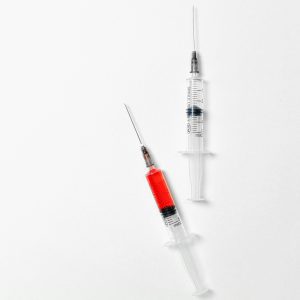
What Is Anemia?
Anemia is a medical condition characterized by a deficiency of red blood cells or hemoglobin in the blood, resulting in reduced oxygen-carrying capacity. This can lead to symptoms such as fatigue, weakness, pale skin, shortness of breath, and an increased heart rate. Anemia can be caused by various factors, including nutritional deficiencies (such as iron, vitamin B12, or folate), chronic diseases, genetic conditions, or blood loss. Diagnosis typically involves blood tests to assess hemoglobin levels and identify the underlying cause. Treatment depends on the specific type and cause of anemia but may include dietary changes, supplements, medications, or, in severe cases, blood transfusions.
Brief History of Anemia
The history of anemia dates back to ancient times, with observations and understanding evolving over the centuries:
- Ancient Civilizations:
- Ancient civilizations, including the Egyptians, Greeks, and Romans, recognized symptoms associated with anemia, such as fatigue and pallor. However, they lacked a comprehensive understanding of the underlying causes.
- Middle Ages:
- During the Middle Ages, the concept of “melancholia” encompassed symptoms now associated with anemia. However, the understanding remained largely speculative and did not involve a clear recognition of the role of blood.
- 17th Century:
- In the 17th century, William Harvey’s groundbreaking work on the circulatory system laid the foundation for understanding the role of blood in transporting oxygen. However, the link between blood and anemia was not fully established.
- 19th Century:
- Advances in microscopy in the 19th century allowed scientists like Paul Langerhans and Thomas Addison to observe abnormalities in red blood cells. Addison’s work on pernicious anemia contributed to understanding the link between anemia and intrinsic factor deficiency.
- Early 20th Century:
- The discovery of specific types of anemia, such as iron-deficiency anemia, by scientists like William Castle and George Whipple, marked significant progress in the early 20th century. Understanding of nutritional factors impacting anemia expanded.
- Mid to Late 20th Century:
- The identification of various forms of anemia, including sickle cell anemia, thalassemia, and aplastic anemia, advanced in the mid to late 20th century. Research on the genetic and molecular basis of these conditions expanded.
- Contemporary Research:
- Advances in genetics, biochemistry, and medical technology continue to deepen our understanding of anemia. Contemporary research focuses on personalized treatment approaches, including targeted therapies and genetic interventions.
Throughout history, observations of anemia’s symptoms were noted, but it wasn’t until more recent centuries that scientific advancements enabled a clearer understanding of its diverse causes and the development of targeted treatments.
| Historical Period | Key Developments |
|---|---|
| Ancient Civilizations | – Recognition of anemia symptoms like fatigue and pallor. |
| – Lack of a comprehensive understanding of underlying causes. | |
| Middle Ages | – Concept of “melancholia” encompassed anemia symptoms. |
| – Limited understanding without clear recognition of blood’s role. | |
| 17th Century | – William Harvey’s circulatory system work laid foundation. |
| – Link between blood and anemia not fully established. | |
| 19th Century | – Microscopy advances allowed observation of red blood cell abnormalities. |
| – Thomas Addison’s work contributed to understanding pernicious anemia. | |
| Early 20th Century | – Discovery of specific types like iron-deficiency anemia marked progress. |
| – Understanding of nutritional factors impacting anemia expanded. | |
| Mid to Late 20th Century | – Identification of various anemias, including genetic and molecular research. |
| – Advances in understanding conditions like sickle cell anemia and thalassemia. | |
| Contemporary Research | – Ongoing research in genetics, biochemistry, and medical technology. |
| – Focus on personalized treatment approaches, including targeted therapies and genetic interventions. |
This table provides a succinct overview of the key developments in the understanding of anemia throughout different historical periods.
What Causes Anemia?
Anemia can be caused by various factors that result in a decrease in the number of red blood cells or a reduction in the amount of hemoglobin, the oxygen-carrying protein within red blood cells. The primary causes of anemia include:
- Nutritional Deficiencies:
- Iron Deficiency Anemia: Insufficient iron intake or poor iron absorption can lead to a shortage of iron needed for hemoglobin synthesis.
- Vitamin B12 Deficiency Anemia: Inadequate intake or absorption of vitamin B12, often seen in conditions like pernicious anemia or malabsorption disorders, can result in anemia.
- Chronic Diseases:
- Chronic Inflammatory Diseases: Conditions such as chronic kidney disease, rheumatoid arthritis, or inflammatory bowel diseases can interfere with the body’s ability to produce red blood cells.
- Chronic Infections: Long-term infections can contribute to anemia due to increased demand on the body’s resources.
- Genetic Factors:
- Hemolytic Anemias: Inherited conditions, such as sickle cell anemia or thalassemia, involve abnormal red blood cell production or increased destruction of red blood cells.
- Hereditary Spherocytosis: An inherited disorder causing spherical-shaped red blood cells, leading to their premature destruction.
- Bone Marrow Disorders:
- Aplastic Anemia: Damage to the bone marrow can result in a reduced production of red blood cells.
- Myelodysplastic Syndromes (MDS): Disorders characterized by dysfunctional blood cell production in the bone marrow.
- Hormonal Factors:
- Hormonal Deficiencies: Conditions affecting hormone production, such as hypothyroidism, can contribute to anemia.
- Blood Loss:
- Acute Blood Loss: Trauma, surgery, or gastrointestinal bleeding can cause a sudden decrease in red blood cell count.
- Chronic Blood Loss: Conditions like gastrointestinal ulcers, heavy menstrual periods, or certain cancers can lead to ongoing blood loss.
- Dietary Factors:
- Folate Deficiency Anemia: Inadequate intake of folate, a B-vitamin found in foods, can lead to anemia.
- Copper Deficiency Anemia: Rare, but insufficient copper intake can affect iron metabolism and lead to anemia.
Understanding the specific cause of anemia is crucial for determining the appropriate treatment approach. Diagnostic tests, including blood tests and, in some cases, bone marrow examinations, help identify the underlying factors contributing to anemia. Treatment may involve addressing the root cause, dietary adjustments, supplements, or, in severe cases, blood transfusions.
What Are the Symptoms of Anemia?
The symptoms of anemia can vary depending on the severity of the condition and its underlying cause. Common symptoms include:
- Fatigue:
- Feeling unusually tired or weak is a hallmark symptom of anemia. This fatigue may be persistent and impact daily activities.
- Weakness:
- Generalized weakness or a sense of physical exhaustion can accompany anemia, affecting strength and stamina.
- Pale Skin:
- Anemia may cause a paleness of the skin, especially in the face, and a loss of the healthy, rosy color.
- Shortness of Breath:
- Insufficient oxygen-carrying capacity can lead to shortness of breath, especially during physical activity or exertion.
- Rapid Heartbeat (Tachycardia):
- The heart may beat faster than normal to compensate for decreased oxygen delivery, resulting in an increased heart rate.
- Dizziness or Lightheadedness:
- Anemia can cause a decrease in blood flow to the brain, leading to feelings of dizziness or lightheadedness.
- Cold Hands and Feet:
- Poor circulation due to reduced red blood cell count may result in cold or numb extremities.
- Headache:
- Some individuals with anemia may experience frequent headaches, particularly those caused by insufficient oxygen reaching the brain.
- Difficulty Concentrating:
- Insufficient oxygen delivery to the brain can affect cognitive function, leading to difficulties concentrating and mental fog.
- Brittle Nails and Pale Nail Beds:
- Changes in the appearance of nails, such as brittleness or paleness, may be indicative of anemia.
- Craving Non-Nutritive Substances (Pica):
- In some cases, individuals with anemia may develop unusual cravings for non-food items, a condition known as pica.
It’s important to note that these symptoms are not exclusive to anemia and can occur in various health conditions. If an individual experiences persistent or severe symptoms, it is advisable to seek medical attention for a thorough evaluation and diagnosis. Diagnosing anemia typically involves blood tests to assess hemoglobin levels and identify the underlying cause.
How is Anemia Diagnosed?
Diagnosing anemia involves a combination of medical history assessment, physical examination, and laboratory tests. Here are the key steps in the diagnostic process:
- Medical History:
- The healthcare provider will inquire about the patient’s medical history, including symptoms, overall health, family history of anemia, and any potential risk factors.
- Physical Examination:
- A physical examination may be conducted to assess symptoms such as paleness, fatigue, rapid heart rate, and other signs associated with anemia. The healthcare provider may also check for potential underlying causes.
- Blood Tests:
- Blood tests are crucial for diagnosing anemia. Common tests include:
- Complete Blood Count (CBC): This test measures the number of red blood cells, white blood cells, and platelets in the blood. It provides information about the size and hemoglobin content of red blood cells.
- Hemoglobin Test: This test directly measures the amount of hemoglobin in the blood. Low hemoglobin levels are indicative of anemia.
- Hematocrit Test: This test measures the percentage of the blood volume occupied by red blood cells. A low hematocrit level is consistent with anemia.
- Peripheral Blood Smear: This test involves examining a sample of blood under a microscope to assess the shape and characteristics of red blood cells.
- Blood tests are crucial for diagnosing anemia. Common tests include:
- Additional Tests:
- Depending on the suspected cause of anemia, additional tests may be ordered. These may include:
- Iron Studies: To evaluate iron levels and storage.
- Vitamin B12 and Folate Tests: To assess levels of these vitamins, especially in cases of megaloblastic anemia.
- Reticulocyte Count: To determine the rate of red blood cell production.
- Bone Marrow Examination: In rare cases, a sample of bone marrow may be taken for further evaluation.
- Depending on the suspected cause of anemia, additional tests may be ordered. These may include:
- Specialized Testing:
- For specific types of anemia, such as hemolytic anemia or hereditary anemias, specialized tests may be performed to identify genetic markers or antibodies.
The combination of these diagnostic tools helps healthcare providers determine the type and cause of anemia. Once a diagnosis is established, appropriate treatment and management strategies can be implemented. It’s important for individuals with symptoms of anemia to consult a healthcare professional for a comprehensive evaluation and diagnosis tailored to their specific circumstances.
What Are the Different Types of Anemia?
Anemia is a broad term encompassing various types, each with distinct causes and characteristics. Some common types of anemia include:
- Iron-Deficiency Anemia:
- Caused by a deficiency of iron, a key component in hemoglobin production. This type is often linked to inadequate dietary iron, blood loss (chronic or acute), or poor iron absorption.
- Vitamin B12 Deficiency Anemia:
- Results from insufficient vitamin B12, crucial for red blood cell production. Causes include dietary deficiencies, malabsorption issues (as seen in pernicious anemia), or conditions affecting the stomach or small intestine.
- Folate Deficiency Anemia:
- Arises from inadequate intake or absorption of folate (vitamin B9), essential for DNA synthesis and red blood cell formation. Common causes include poor diet, malabsorption, or certain medications.
- Aplastic Anemia:
- Characterized by a decrease in red blood cells, white blood cells, and platelets due to bone marrow dysfunction. Causes may include exposure to certain medications, toxins, or autoimmune disorders.
- Hemolytic Anemia:
- Results from the premature destruction of red blood cells, either due to an inherited condition (hereditary hemolytic anemias) or acquired factors like autoimmune disorders, infections, or certain medications.
- Sickle Cell Anemia:
- A hereditary disorder where red blood cells have an abnormal, crescent shape, leading to increased destruction and reduced oxygen-carrying capacity. It primarily affects individuals of African, Mediterranean, or Middle Eastern descent.
- Thalassemia:
- A group of inherited blood disorders characterized by abnormal hemoglobin production, resulting in decreased red blood cell production. There are alpha and beta thalassemia variants, each with different severities.
- Chronic Disease Anemia:
- Occurs in association with chronic inflammatory or medical conditions such as chronic kidney disease, inflammatory bowel diseases, or certain cancers. Inflammation can disrupt normal red blood cell production.
- Hemorrhagic Anemia:
- Caused by acute or chronic blood loss, leading to a reduction in red blood cell volume. Causes include gastrointestinal bleeding, heavy menstrual periods, trauma, or surgery.
- Megaloblastic Anemia:
- Characterized by large, immature red blood cells due to impaired DNA synthesis. Vitamin B12 deficiency and folate deficiency are common causes.
- Hemoglobinopathies:
- Genetic disorders affecting the structure or production of hemoglobin, such as thalassemia and sickle cell anemia.
These types represent a subset of the diverse range of anemias, each requiring specific diagnostic approaches and tailored treatment strategies. Identifying the precise type of anemia is crucial for effective management and addressing the underlying causes.
How is Anemia Treated?
The treatment of anemia depends on its underlying cause, severity, and the specific type of anemia. Common treatment approaches include:
- Iron Supplementation:
- For iron-deficiency anemia, oral iron supplements are often prescribed to replenish iron stores. In some cases, intravenous iron may be recommended if oral supplements are not well-tolerated or effective.
- Vitamin Supplements:
- In cases of vitamin B12 or folate deficiency anemia, supplementation with the deficient vitamin is necessary. This may involve oral or, in certain situations, intramuscular injections.
- Blood Transfusion:
- In severe cases of anemia, especially when there is a rapid or significant loss of blood, blood transfusions may be required to quickly restore red blood cell levels and improve oxygen-carrying capacity.
- Erythropoiesis-Stimulating Agents (ESAs):
- In chronic kidney disease or certain other conditions associated with reduced red blood cell production, ESAs may be prescribed to stimulate the bone marrow to produce more red blood cells.
- Treatment of Underlying Conditions:
- Addressing the root cause of anemia is crucial. This may involve managing chronic diseases, such as inflammatory conditions, chronic kidney disease, or cancer, which contribute to anemia.
- Bone Marrow Stimulants:
- In some cases, medications that stimulate bone marrow activity may be used to increase the production of red blood cells.
- Lifestyle and Dietary Changes:
- Adopting a diet rich in iron, vitamin B12, and folate can help prevent and manage certain types of anemia. This includes incorporating iron-rich foods, such as leafy greens, lean meats, and fortified cereals.
- Hormone Therapy:
- Hormone therapy may be considered for certain types of anemia, especially those associated with hormonal imbalances, such as in hypothyroidism.
- Treatment of Hemolytic Anemia:
- Managing the underlying cause of hemolytic anemia is essential. This may involve medications to suppress the immune system, blood transfusions, or, in severe cases, splenectomy (removal of the spleen).
- Genetic and Stem Cell Therapies:
- For inherited forms of anemia, such as thalassemia or sickle cell anemia, advanced therapies, including gene therapy and stem cell transplantation, may be considered in certain cases.
It’s crucial for individuals with anemia to receive a thorough evaluation by healthcare professionals to determine the most appropriate treatment plan. Treatment is often individualized based on the specific type and cause of anemia, and regular follow-up assessments are important to monitor progress and adjust the treatment as needed.
Can Anemia be Prevented?
Preventing anemia involves addressing its underlying causes and adopting lifestyle practices to maintain optimal iron, vitamin B12, and folate levels. Here are some general preventive measures:
- Nutrient-Rich Diet:
- Consume a well-balanced diet rich in iron, vitamin B12, and folate. Include foods such as lean meats, fish, poultry, beans, lentils, leafy green vegetables, fortified cereals, and dairy products.
- Iron Absorption Enhancers:
- Combine iron-rich foods with sources of vitamin C (citrus fruits, tomatoes, bell peppers) to enhance iron absorption. Avoid consuming iron-rich foods with substances that inhibit absorption, such as tea and coffee, during meals.
- Supplements:
- If at risk for nutritional deficiencies, consider dietary supplements after consulting with a healthcare professional. This is particularly relevant for individuals with dietary restrictions or conditions affecting nutrient absorption.
- Manage Chronic Diseases:
- Effectively manage chronic conditions, such as chronic kidney disease, inflammatory bowel diseases, or cancer, which can contribute to anemia. Regular medical check-ups and adherence to treatment plans are essential.
- Prenatal Care:
- Pregnant women should receive adequate prenatal care, including iron supplementation if recommended by healthcare providers, to prevent iron-deficiency anemia, which is common during pregnancy.
- Hygiene and Infection Control:
- Prevent and control infections, as certain infections can contribute to anemia. Practicing good hygiene and receiving vaccinations, when appropriate, can help.
- Regular Exercise:
- Engage in regular physical activity, which promotes overall health and can contribute to better blood circulation and oxygenation.
- Avoid Excessive Alcohol Consumption:
- Limit alcohol intake, as excessive alcohol consumption can interfere with nutrient absorption and contribute to nutritional deficiencies.
- Periodic Check-ups:
- Undergo periodic health check-ups to monitor overall health, detect potential issues early, and receive appropriate medical advice.
- Genetic Counseling:
- For individuals with a family history of inherited anemias, such as thalassemia or sickle cell anemia, genetic counseling can provide information about the risk and available preventive measures.
While certain forms of anemia may not be entirely preventable due to genetic factors, adopting a healthy lifestyle and being proactive about managing underlying health conditions can significantly reduce the risk of developing anemia. Individuals with specific concerns or risk factors should consult healthcare professionals for personalized guidance and preventive strategies.
Is Anemia Life-Threatening?
The severity of anemia can vary widely, and while many cases are mild and manageable, severe anemia can be life-threatening if left untreated or if the underlying cause is a critical medical condition. The potential dangers of anemia are influenced by factors such as the rapidity of onset, the degree of blood loss, and the body’s ability to compensate for reduced oxygen-carrying capacity.
Life-threatening complications of severe anemia may include:
- Organ Failure:
- In severe cases, the lack of oxygen delivery to vital organs, especially the heart and brain, can lead to organ failure.
- Cardiovascular Complications:
- Severe anemia places additional strain on the cardiovascular system, potentially leading to heart failure or cardiac events.
- Hypovolemic Shock:
- Acute and significant blood loss, whether from injury, surgery, or gastrointestinal bleeding, can lead to hypovolemic shock, a medical emergency that requires immediate intervention.
- Complications During Pregnancy:
- Severe anemia in pregnant women may increase the risk of complications such as preterm birth, low birth weight, and maternal mortality.
- Impaired Cognitive Function:
- In cases of chronic anemia, especially when associated with inadequate oxygen supply to the brain, cognitive impairment and developmental issues may occur, particularly in children.
It is essential to recognize and address anemia promptly, especially when symptoms are severe or persistent. Medical attention is crucial to determine the specific type of anemia, identify the underlying cause, and implement appropriate treatment. Treatment may involve correcting nutritional deficiencies, managing chronic conditions, administering blood transfusions, or addressing other contributing factors.
Regular check-ups, monitoring of symptoms, and adherence to treatment plans can significantly reduce the risk of complications associated with anemia. Individuals experiencing symptoms of anemia, such as fatigue, weakness, or shortness of breath, should seek medical advice for a thorough evaluation and appropriate management.
Websites and Articles to Delve into the Aspects of Anemia
Various reputable sources, including medical institutions like Mayo Clinic, Cleveland Clinic, and Mount Sinai, along with health platforms like WebMD and Medical News Today, provide comprehensive and accessible information on anemia, covering its causes, symptoms, diagnosis, and treatment options for individuals seeking reliable insights into this blood disorder.
- Penn Medicine – Anemia
- Penn Medicine provides information on anemia, covering its definition, causes, symptoms, and treatment options. It highlights the importance of iron, vitamin B12, and folate in preventing anemia.
- Mayo Clinic – Anemia
- Mayo Clinic offers comprehensive information on anemia, including its symptoms, causes, risk factors, and complications. It provides insights into the various types of anemia and diagnostic approaches.
- WebMD – Understanding Anemia
- WebMD provides an overview of anemia basics, covering symptoms, causes, types, diagnosis, and treatment options. It aims to help individuals understand and manage anemia effectively.
- Cleveland Clinic – Anemia
- Cleveland Clinic’s information on anemia includes details about its causes, symptoms, diagnosis, and treatment. It emphasizes the importance of addressing underlying conditions leading to anemia.
- Wikipedia – Anemia
- Wikipedia offers a comprehensive overview of anemia, covering its definition, classification, epidemiology, and history. It provides links to various aspects of anemia for more in-depth exploration.
- Medical News Today – Anemia
- Medical News Today provides articles on anemia, including its causes, symptoms, diagnosis, and treatment options. It also explores related topics, such as iron deficiency anemia.
- MedlinePlus – Anemia
- MedlinePlus offers consumer-friendly information on anemia, covering its symptoms, diagnosis, treatment, and prevention. It includes links to related resources for a broader understanding.
- American Society of Hematology – Anemia
- The American Society of Hematology provides educational resources on anemia, addressing its causes, types, and treatment options. It aims to empower patients with knowledge about their condition.
- HealthDirect – Anaemia
- HealthDirect, an Australian health information website, offers information on anemia (referred to as anaemia), covering causes, symptoms, and treatment options. It provides practical advice for individuals dealing with anemia.
- Healthline – Anemia
- Healthline’s information on anemia includes articles covering causes, symptoms, diagnosis, and treatment options. It offers insights into lifestyle changes to manage anemia effectively.
- Mount Sinai – Anemia
- Mount Sinai’s health library provides detailed information on anemia, including its causes, symptoms, and treatment options. It aims to educate individuals about this common blood disorder.
- MedicineNet – Anemia
- MedicineNet offers an article on anemia, covering its definition, symptoms, causes, diagnosis, and treatment. It provides practical insights into managing and preventing anemia.
These websites offer valuable resources for individuals seeking information about anemia, ranging from reputable medical institutions to informative health platforms. Always consult with healthcare professionals for personalized advice and guidance.
Summary
Anemia is a medical condition characterized by a deficiency of red blood cells or hemoglobin, resulting in reduced oxygen-carrying capacity. Early observations of its effects date back to ancient civilizations, with a formal understanding evolving over the centuries. In the 19th century, scientific exploration of respiratory physiology contributed to insights into anemia’s mechanisms. Causes vary and include nutritional deficiencies (iron, vitamin B12, folate), chronic diseases, genetic factors, and blood loss. Symptoms encompass fatigue, weakness, pale skin, shortness of breath, and rapid heart rate. Diagnosis involves medical history, physical examination, and blood tests like complete blood count and hemoglobin measurement.
Treatment strategies depend on the underlying cause and may include iron or vitamin supplements, blood transfusions, or addressing chronic conditions. Prevention involves a nutrient-rich diet, managing chronic diseases, and periodic check-ups. While many cases are mild, severe anemia can be life-threatening, leading to complications such as organ failure or hypovolemic shock. Timely diagnosis and appropriate treatment are crucial for mitigating risks associated with anemia, emphasizing the importance of regular medical monitoring and adherence to treatment plans.






